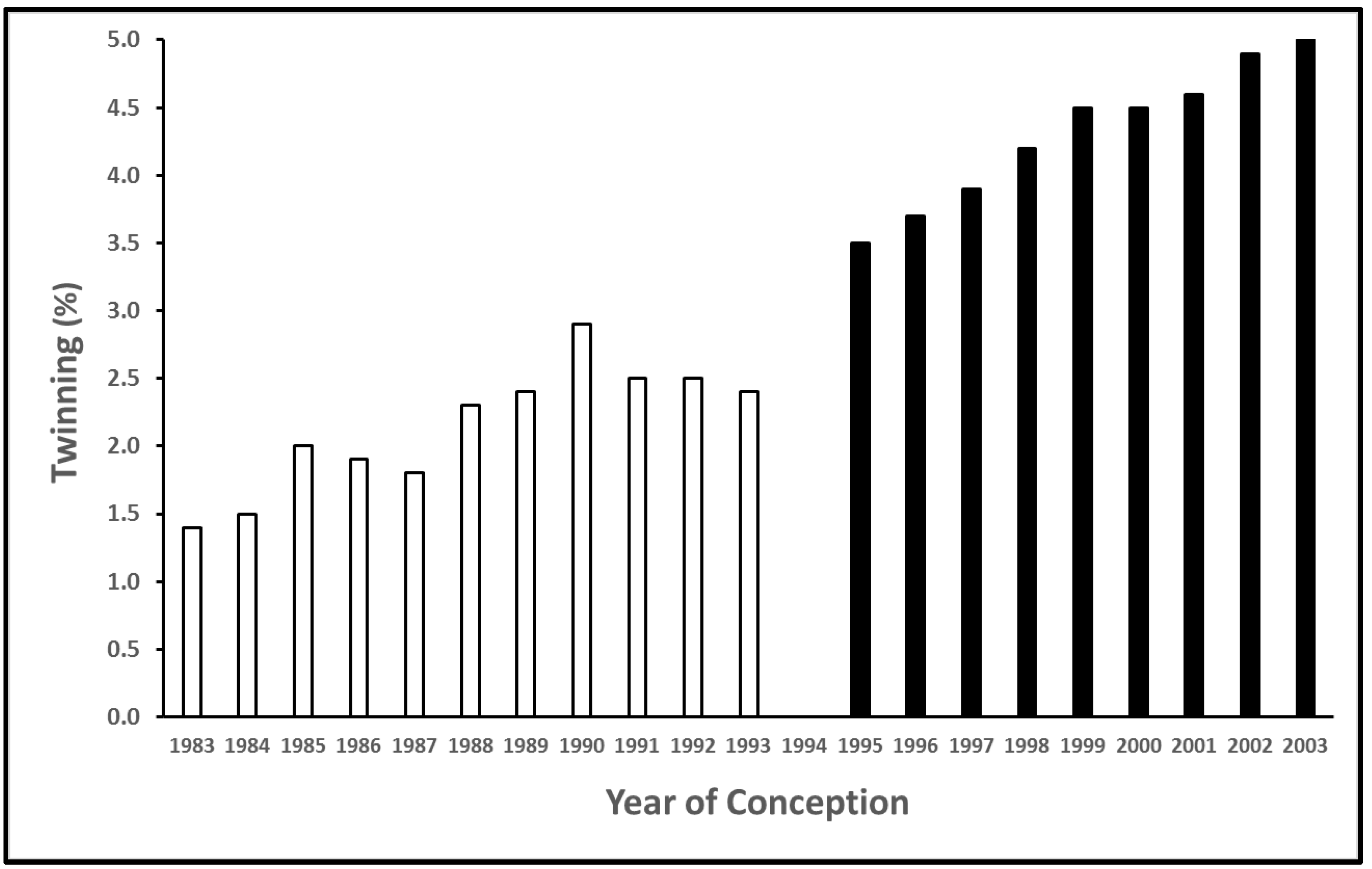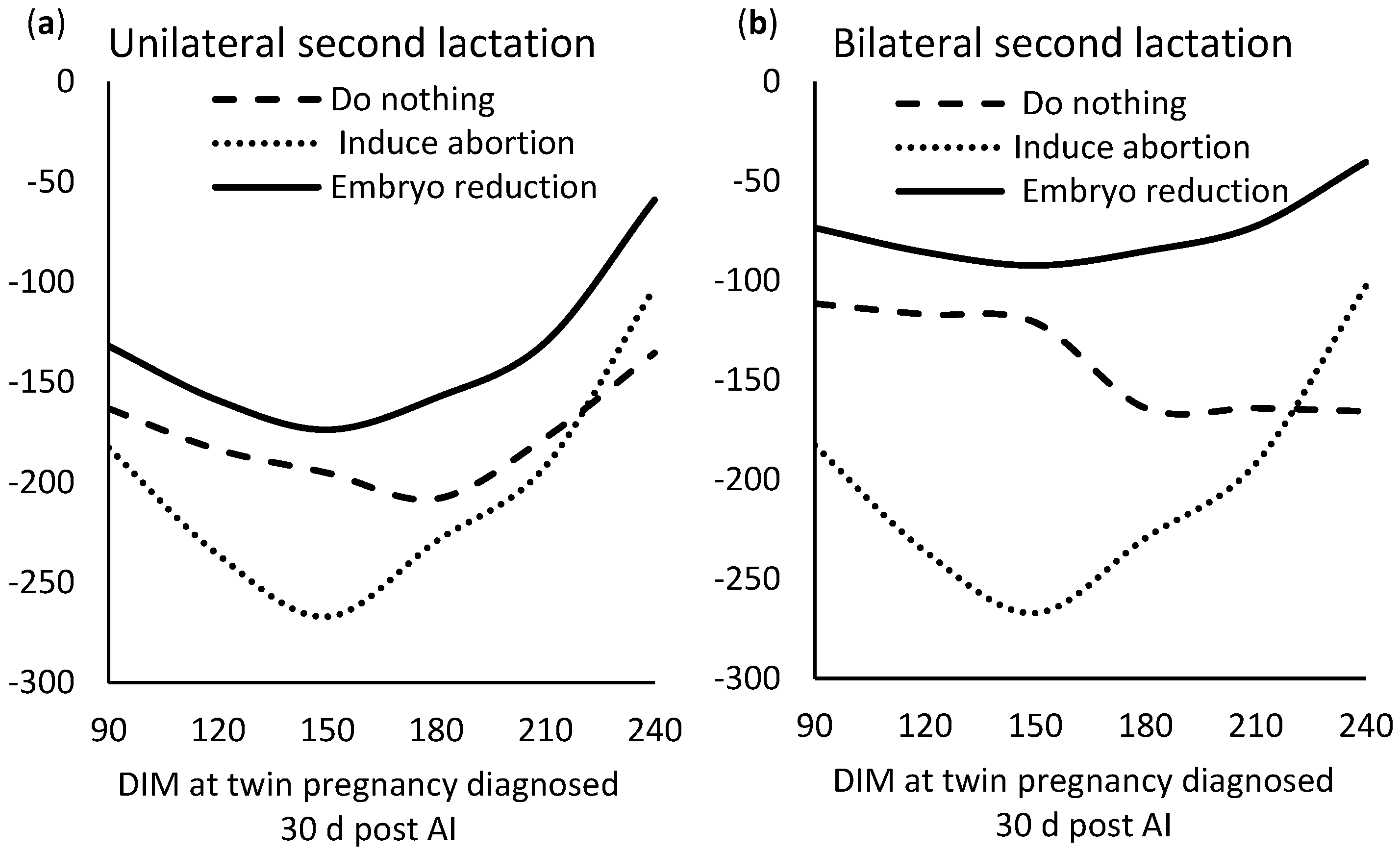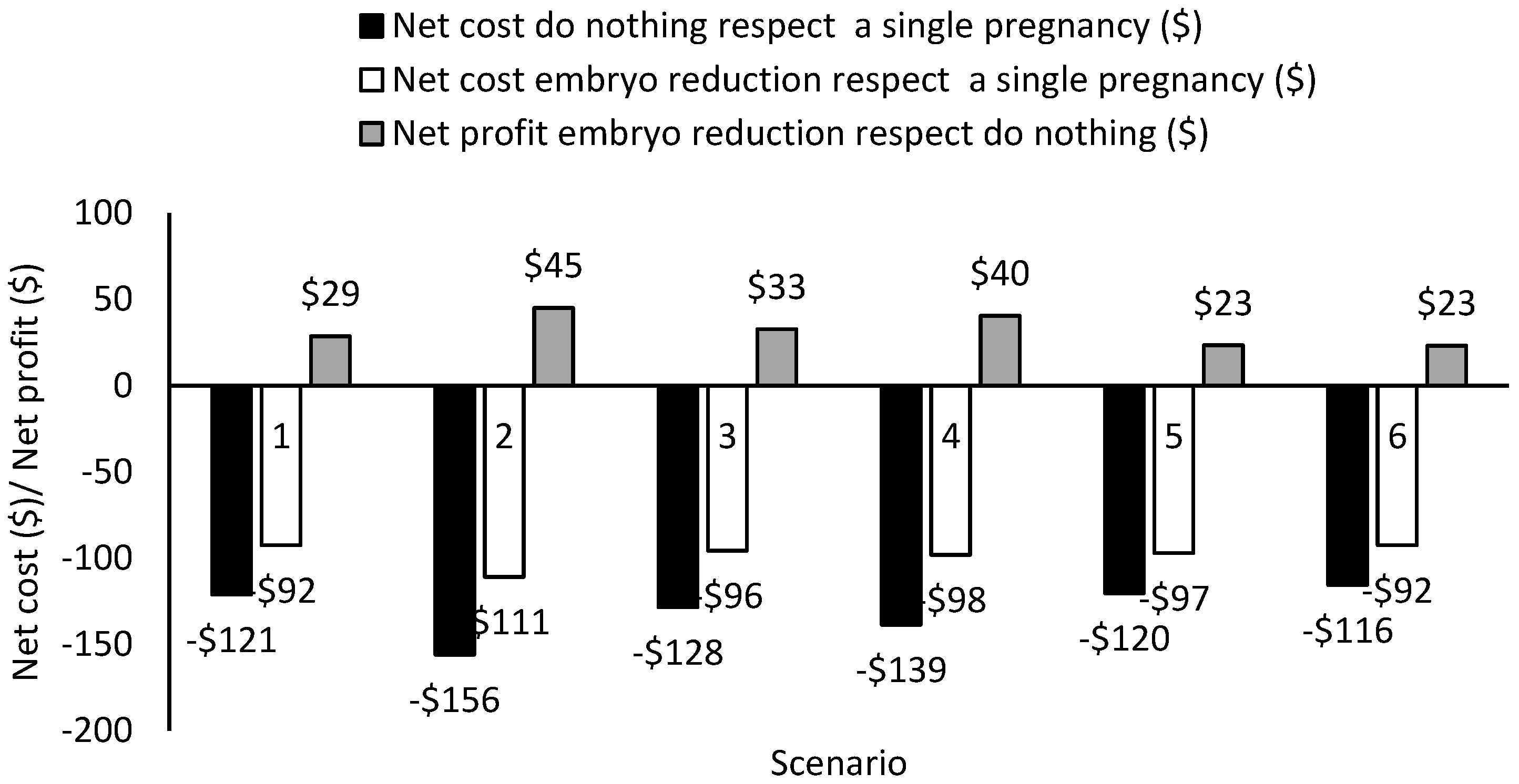Economics of Twin Pregnancies in Dairy Cattle
Abstract
:Simple Summary
Abstract
1. Introduction
2. Economic Impacts of Twinning
3. Economic Models to Assess Twining
4. Management Strategies to Avoid Twinning
5. Management Strategies to Mitigate Negative Effects of Twinning
5.1. Pregnancy Termination
5.2. Selective Reduction
5.3. Nutritional Management during the Transition Period
6. Economics of Twinning Management Strategies
7. Conclusions
Author Contributions
Funding
Institutional Review Board Statement
Informed Consent Statement
Data Availability Statement
Conflicts of Interest
References
- De Rose, E.P.; Wilton, J.W. Productivity and profitability of twin births in beef cattle. J. Anim. Sci. 1991, 69, 3085–3093. [Google Scholar] [CrossRef] [PubMed]
- Guerra-Martinez, P.; Dickerson, G.E.; Anderson, G.B.; Green, R.D. Embryo-transfer twinning and performance efficiency in beef production. J. Anim. Sci. 1990, 68, 4039–4050. [Google Scholar] [CrossRef]
- Fricke, P.M. Review: Twinning in dairy cattle. Prof. Anim. Sci. 2001, 17, 61–67. [Google Scholar] [CrossRef] [Green Version]
- Carvalho, P.D.; Santos, V.G.; Fricke, H.P.; Hernandez, L.L.; Fricke, P.M. Effect of manipulating progesterone before timed artificial insemination on reproductive and endocrine outcomes in high-producing multiparous Holstein cows. J. Dairy Sci. 2019, 102, 7509–7521. [Google Scholar] [CrossRef]
- Martins, J.P.N.; Wang, D.; Mu, N.; Rossi, G.F.; Martini, A.P.; Martins, V.R.; Pursley, J.R. Level of circulating concentrations of progesterone during ovulatory follicle development affects timing of pregnancy loss in lactating dairy cows. J. Dairy Sci. 2018, 101, 10505–10525. [Google Scholar] [CrossRef] [Green Version]
- Kinsel, M.L.; Marsh, W.E.; Ruegg, P.L.; Etherington, W.G. Risk factors for twinning in dairy cows. J. Dairy Sci. 1998, 81, 989–993. [Google Scholar] [CrossRef]
- Silva del Río, N.; Stewart, S.; Rapnicki, P.; Chang, Y.M.; Fricke, P.M. An observational analysis of twin births, calf sex ratio, and calf mortality in Holstein dairy cattle. J. Dairy Sci. 2007, 90, 1255–1264. [Google Scholar] [CrossRef] [Green Version]
- Nielen, M.; Sclmk:ken, Y.H.; Scholl, D.T.; Wilbrink, H.J.; Brand, A. Twinning in dairy cattle: A study of risk factors and effects. Teriogenology 1989, 32, 845–862. [Google Scholar] [CrossRef]
- Echternkamp, S.E.; Gregory, K.E. Effects of twinning on gestation length, retained placenta, and dystocia. J. Anim. Sci. 1999, 77, 39–47. [Google Scholar] [CrossRef] [Green Version]
- Gregory, K.E.; Echternkamp, S.E.; Cundiff, L.V. Effects of twinning on dystocia, calf survival, calf growth, carcass traits, and cow productivity. J. Anim. Sci. 1996, 74, 1223–1233. [Google Scholar] [CrossRef] [PubMed]
- Markusfeld, O. Periparturient traits in seven high dairy herds. Incidence rates, association with parity, and interrelationships among traits. J. Dairy Sci. 1987, 70, 158–166. [Google Scholar] [CrossRef]
- Pfau, K.O.; Bartlett, J.W.; Shuart, C.E. A study of multiple births in a Holstein-Friesian herd. J. Dairy Sci. 1948, 31, 241–254. [Google Scholar] [CrossRef]
- Eddy, R.G.; Davies, O.; David, C. An economic assessment of twin births in British dairy herds. Vet. Rec. 1991, 129, 526–529. [Google Scholar]
- Andreu-Vázquez, C.; Garcia-Ispierto, I.; Ganau, S.; Fricke, P.M.; López-Gatius, F. Effects of twinning on the subsequent reproductive performance and productive lifespan of high-producing dairy cows. Theirogenology 2012, 78, 2061–2070. [Google Scholar] [CrossRef]
- Silva del Río, N.; Colloton, J.; Fricke, P.M. Factors affecting pregnancy loss for single and twin pregnancies in a high-producing dairy herd. Theriogenology 2009, 71, 1462–1471. [Google Scholar] [CrossRef]
- Erb, R.E.; Morrison, R.A. Effects of twinning on reproductive efficiency in a Holstein-Friesian herd. J. Dairy Sci. 1959, 42, 512–519. [Google Scholar] [CrossRef]
- Foote, R.H. Factors affecting gestation length in dairy cattle. Theriogenology 1981, 6, 553–559. [Google Scholar] [CrossRef]
- Bowman, J.C.; Frood, I.J.M.; Wood, P.D.P. A note on the variation and heritability of twinning in British Friesian cattle. Anim. Prod. 1970, 12, 531–533. [Google Scholar] [CrossRef]
- Bowman, J.C.; Hendy, C.R.C. The incidence, repeatability and effect on dam performance of twinning in British Friesian cattle. Anim. Prod. 1970, 12, 55–62. [Google Scholar] [CrossRef]
- Beerepoot, G.M.M.; Dykhuizen, A.A. The economics of naturally occurring twinning in dairy cattle. J. Dairy Sci. 1992, 75, 1044–1051. [Google Scholar] [CrossRef]
- Gaspárdy, A.; Sheridan, J.; Ari, M.; Gulyás, L. Twin calving and its connection to other economically important traits in dairy cattle. In Ruminants: The Husbandry, Economic and Health Aspects; Abubakar, M., Ed.; InTech: Rijeka, Croatia, 2018; pp. 61–82. [Google Scholar]
- Fricke, P.M. Scanning the future—Ultrasonography as a reproductive management tool for dairy cattle. J. Dairy Sci. 2002, 85, 1918–1926. [Google Scholar] [CrossRef]
- Silva del Río, N.; Kirkpatrick, B.W.; Fricke, P.M. Observed frequency of monozygotic twinning in Holstein dairy cattle. Theriogenology 2006, 66, 1292–1299. [Google Scholar] [CrossRef]
- Mur-Novales, R.; Lopez-Gatius, F.; Fricke, P.M.; Cabrera, V.E. An economic evaluation of management strategies to mitigate the negative impact of twinning in dairy herds. J. Dairy Sci. 2018, 101, 8335–8349. [Google Scholar] [CrossRef]
- Andreu-Vázquez, C.; Garcia-Ispierto, I.; López-Béjar, M.; de Sousa, N.M.; Beckers, J.F.; López-Gatius, F. Clinical implications of induced twin reduction in dairy cattle. Theriogenology 2011, 76, 512–521. [Google Scholar] [CrossRef] [PubMed]
- Fodor, I.; Kern, L.; Varga-Balogh, O.G.; Gábor, G.; Ózsvári, L. The prevalence and impact of twinning and stillbirth on reproductive performance and their economic losses in large Hungarian dairy herds. Anim. Biol. 2019, 21, 21–24. [Google Scholar] [CrossRef] [Green Version]
- Fricke, P.M.; Wiltbank, M.C. Effect of milk production on the incidence of double ovulation in dairy cows. Theriogenology 1999, 52, 1133–1143. [Google Scholar] [CrossRef]
- Lopez, H.; Caraviello, D.Z.; Satter, L.D.; Fricke, P.M.; Wiltbank, M.C. Relationship between level of milk production and multiple ovulations in lactating dairy cows. J. Dairy Sci. 2005, 88, 2783–2793. [Google Scholar] [CrossRef]
- Bicalho, R.; Cheong, S.H.; Galvao, K.N.; Warnick, L.D.; Guard, C.L. Effect of twin birth calving on milk production, reproductive performance and survival of lactating cows. J. Am. Vet. Med. Assoc. 2007, 23, 1390–1397. [Google Scholar] [CrossRef] [PubMed]
- Sawa, A.; Bogucki, M.; Glowska, M. Effect of single and multiple pregnancies on performance of primiparous and multiparous cows. Arch. Anim. Breed. 2015, 58, 43–48. [Google Scholar] [CrossRef]
- Caraviello, D.Z.; Weigel, K.A.; Fricke, P.M.; Wiltbank, M.C.; Florent, M.J.; Cook, N.B.; Nordlund, K.V.; Zwald, N.R.; Rawson, C.M. Survey of management practices on reproductive performance of dairy cattle on large US commercial farms. J. Dairy Sci. 2006, 89, 4723–4735. [Google Scholar] [CrossRef] [Green Version]
- Norman, D.; Wright, J.R.; Hubbard, S.M.; Miller, R.H.; Hutchison, J.L. Reproductive status of Holstein and Jersey cows in the United States. J. Dairy Sci. 2009, 92, 3517–3528. [Google Scholar] [CrossRef]
- Carvalho, P.D.; Santos, V.G.; Giordano, J.O.; Wiltbank, M.C.; Fricke, P.M. Development of fertility programs to achieve high 21-day pregnancy rates in high-producing dairy cows. Theriogenology 2018, 114, 165–172. [Google Scholar] [CrossRef] [PubMed]
- Stevenson, J.S.; Portaluppi, M.A.; Tenhouse, D.E. Factors influencing upfront single- and multiple-ovulation incidence, progesterone, and luteolysis before a timed insemination resynchronization protocol. J. Dairy Sci. 2007, 90, 5542–5551. [Google Scholar] [CrossRef] [PubMed]
- Cerri, R.L.A.; Chebel, R.C.; Rivera, F.; Narciso, C.D.; Oliveira, R.A.; Thatcher, W.W.; Santos, J.E.P. Concentration of progesterone during the development of the ovulatory follicle: I. Ovarian and embryonic responses. J. Dairy Sci. 2011, 94, 3342–3351. [Google Scholar] [CrossRef] [Green Version]
- López-Gatius, F.; Hunter, R.H.F. Spontaneous reduction of advanced twin embryos: Its occurrence and clinical relevance in dairy cattle. Theriogenology 2005, 63, 118–125. [Google Scholar] [CrossRef] [PubMed]
- Fricke, P.M.; Carvalho, P.D.; Lucy, M.C.; Curran, F.; Herlihy, M.M.; Waters, S.M.; Larkin, J.A.; Crowe, M.A.; Butler, S.T. Effect of manipulating progesterone before timed artificial insemination on reproductive and endocrine parameters in seasonal-calving pasture-based Holstein-Friesian cows. J. Dairy Sci. 2016, 99, 6780–6792. [Google Scholar] [CrossRef]
- Harrison, R.O.; Ford, S.P.; Young, J.W.; Conley, A.J.; Freeman, A.E. Increased milk production versus reproductive and energy status of high producing dairy cows. J. Dairy Sci. 1990, 73, 2749–2758. [Google Scholar] [CrossRef] [PubMed]
- Sangsritavong, S.; Combs, D.K.; Sartori, R.; Armentano, L.E.; Wiltbank, M.C. High feed intake increases liver blood flow and metabolism of progesterone and estradiol-17β in dairy cattle. J. Dairy Sci. 2002, 85, 2831–2842. [Google Scholar] [CrossRef] [PubMed] [Green Version]
- Souza, A.H.; Ayers, H.; Ferreira, R.M.; Wiltbank, M.C. A new presynchronization system (Double-Ovsynch) increases fertility at first postpartum timed AI in lactating dairy cows. Theriogenology 2008, 70, 208–215. [Google Scholar] [CrossRef]
- Herlihy, M.M.; Giordano, J.O.; Souza, A.H.; Ayres, H.; Ferriera, R.M.; Keskin, A.; Nascimento, A.B.; Guenther, J.N.; Gaska, J.M.; Kacuba, S.J.; et al. Presynchronization with Double-Ovsynch improves fertility at first postpartum artificial insemination in lactating dairy cows. J. Dairy Sci. 2012, 95, 7003–7014. [Google Scholar] [CrossRef]
- Wiltbank, M.C.; Baez, G.M.; Cochrane, F.; Barletta, R.V.; Trayford, C.R.; Joseph, R.T. Effect of a second treatment with prostaglandin F2α during the Ovsynch protocol on luteolysis and pregnancy in dairy cows. J. Dairy Sci. 2015, 98, 8644–8654. [Google Scholar] [PubMed] [Green Version]
- Ricci, A.; Li, M.; Fricke, P.M.; Cabrera, V.E. Short Communication: Economic impact among 7 reproductive programs for lactating dairy cows including a sensitivity analysis of the cost of hormonal treatments. J. Dairy Sci. 2020, 103, 5654–5661. [Google Scholar] [CrossRef] [PubMed]
- Giordano, J.O.; Guenther, J.N.; Lopes, G., Jr.; Fricke, P.M. Changes in serum pregnancy-associated glycoprotein, pregnancy-specific protein B, and progesterone concentrations before and after induction of pregnancy loss in lactating dairy cows. J. Dairy Sci. 2012, 95, 683–697. [Google Scholar] [CrossRef] [Green Version]
- Ferguson, J.D.; Galligan, D.T. The value of pregnancy diagnosis—A revisit to an old art. In Proceedings of the Theriogenology Annual Conference, Milwaukee, WI, USA, 13 August 2011; Society of Theriogenology: Montgomery, AL, USA, 2011. [Google Scholar]
- Galligan, D.T.; Ferguson, J.; Munson, R.; Remsburg, D.; Skidmore, A. Economic Concepts Regarding Early Pregnancy Testing. In Proceedings of the 42nd Annual Conference of the American Association of Bovine Practitioners, Omaha, NE, USA, 10–12 September 2009; AABP: Auburn, AL, USA, 2009; pp. 48–53. [Google Scholar]
- Giordano, J.O.; Fricke, P.M.; Cabrera, V.E. Economics of resynchronization strategies including chemical tests to identify non-pregnant cows. J. Dairy Sci. 2013, 96, 949–961. [Google Scholar] [CrossRef] [Green Version]
- Van Vleck, L.D.; Gregory, K.E.; Echternkamp, S.E. Ovulation rate and twinning rate in cattle: Heritabilities and genetic correlation. J. Anim Sci. 1991, 69, 3213–3219. [Google Scholar] [PubMed] [Green Version]
- Gregory, K.E.; Bennett, G.L.; Van Vleck, L.D.; Echternkamp, S.E.; Cundiff, L.V. Genetic and environmental parameters for ovulation rate, twinning rate, and weight traits in a cattle population selected for twinning. J Anim. Sci. 1997, 75, 1213–1222. [Google Scholar] [CrossRef] [Green Version]
- Bendixen, P.H.; Oltenacu, P.A.; Andersson, L. Case-referent study of cystic ovaries as a risk indicator for twin calvings in dairy cows. Theriogenology 1989, 31, 1059–1066. [Google Scholar] [CrossRef]
- Santos, J.E.P.; Thatcher, W.W.; Chebel, R.C.; Cerri, R.L.A.; Galvão, K.N. The effect of embryonic death rates in cattle on the efficacy of estrus synchronization programs. Animal Reprod. Sci. 2004, 82, 513–535. [Google Scholar] [CrossRef]
- Echternkamp, S.E.; Thallman, R.M.; Cushman, R.A.; Allan, M.F.; Gregory, K.E. Increased calf production in cattle selected for twin ovulations. J. Anim. Sci. 2007, 85, 3239–3248. [Google Scholar] [CrossRef] [Green Version]
- Iberico, G.; Mavarro, J.; Blasco, L.; Simon, C.; Pellicer, A.; Remohi, J. Embryo reduction of multifetal pregnancies following assisted reproduction treatment: A modification of the transvaginal ultrasound-guided technique. Hum. Reprod. 2000, 15, 2228–2233. [Google Scholar] [CrossRef] [Green Version]
- Macpherson, M.L.; Reimer, J.M. Twin reduction in the mare: Current options. Anim. Reprod. Sci. 2000, 60, 233–244. [Google Scholar] [CrossRef]
- Frazer, G.S. Twins. In Current Therapy in Equine Medicine, 5th ed.; Robinson, N.E., Ed.; Elsevier Science: Amsterdam, The Netherlands, 2003; pp. 245–248. [Google Scholar]
- Koong, L.J.; Anderson, G.B.; Garrett, W.N. Maternal energy status of beef cattle during single and twin pregnancy. J. Anim. Sci. 1982, 54, 480–484. [Google Scholar] [CrossRef] [PubMed]
- Nishida, T.; Kurihara, M.; Terada, F.; Shibata, M. Energy requirements of pregnant Holstein dairy cows carrying single or twin Japanese black fetuses in late pregnancy. Anim. Sci. Technol. 1997, 68, 572–578. [Google Scholar] [CrossRef] [Green Version]
- Van Saun, R.J. Effects of Undegradable Protein Fed Prepartum on Subsequent Lactation, Reproduction, and Health in Holstein Dairy Cattle. Ph.D. Thesis, Cornell University, Ithaca, NY, USA, 1993. [Google Scholar]
- Bell, M.J.; Roberts, D.J. Effect of twinning on the feed intake, performance, and health of dairy cows. Livest Prod. Sci. 2007, 107, 274–281. [Google Scholar] [CrossRef]
- Silva del Río, N.; Fricke, P.M.; Grummer, R.R. Effects of twin pregnancy and dry period feeding strategy on milk production, energy balance, and metabolic profiles in dairy cows. J. Anim. Sci. 2010, 88, 1048–1060. [Google Scholar] [CrossRef] [PubMed] [Green Version]



| Reference | Losses (US$) | Gains (US$) | Net Loss (US$) |
|---|---|---|---|
| [13] 1 | −212 | +100 | −112 |
| [20] | −171 | +63 | −108 |
| 2 [24] | −161 | ||
| Unilateral | −200 | ||
| Bilateral | −150 | ||
| First lactation | −180 | ||
| Second lactation | −130 | ||
| >Second lactation | −120 | ||
| [26] | −59 | −59 |
| Item | n | Loss Rate before 90 d/% (n/n) |
|---|---|---|
| Unilateral twin pregnancy | 27 | |
| Control | 14 | 64 (9/14) |
| Manual twin reduction | 13 | 54 (7/13) |
| Bilateral twin pregnancy | 28 | |
| Control | 14 | 0 (0/14) |
| Manual twin reduction | 14 | 29 (4/14) |
Publisher’s Note: MDPI stays neutral with regard to jurisdictional claims in published maps and institutional affiliations. |
© 2021 by the authors. Licensee MDPI, Basel, Switzerland. This article is an open access article distributed under the terms and conditions of the Creative Commons Attribution (CC BY) license (http://creativecommons.org/licenses/by/4.0/).
Share and Cite
Cabrera, V.E.; Fricke, P.M. Economics of Twin Pregnancies in Dairy Cattle. Animals 2021, 11, 552. https://doi.org/10.3390/ani11020552
Cabrera VE, Fricke PM. Economics of Twin Pregnancies in Dairy Cattle. Animals. 2021; 11(2):552. https://doi.org/10.3390/ani11020552
Chicago/Turabian StyleCabrera, Victor E., and Paul M. Fricke. 2021. "Economics of Twin Pregnancies in Dairy Cattle" Animals 11, no. 2: 552. https://doi.org/10.3390/ani11020552
APA StyleCabrera, V. E., & Fricke, P. M. (2021). Economics of Twin Pregnancies in Dairy Cattle. Animals, 11(2), 552. https://doi.org/10.3390/ani11020552







